The Japanese lifestyle of taking off one’s shoes and sitting on the floor cannot be described without mentioning tatami. The widespread use of tatami plays an important role in the Japanese lifestyle. In this article, I would like to dive into the Japanese culture related to tatami.
History of Tatami
Tatami is a unique architectural material specific to Japan and has developed into an integral part of Japanese culture. During the Heian period (794-1185), it is said that the upper classes placed tatami mats in some parts of their rooms. Later, with the spread of the tea ceremony by Sen no Rikyu (千利休, 1522-1591), the concept of the tea room emerged, and tatami came to cover the entire room. Tatami became an indispensable part of the traditional Japanese-style room known as “shoin- zukuri’ (書院造). During the Edo period, tatami was regarded as a crucial element in important buildings such as castles and mansions. It is said that tatami began to spread among common people during the Meiji period (1868-1912). After World War Ⅱ, Westernization rapidly progressed, which led to a transition from a lifestyle of sitting on the floor to using chairs, and carpets began to gain popularity. However, tatami rooms remained fundamental in residences in the Showa period (1926-1989).

The Benefits of Tatami
Tatami is traditionally made of a base layer of compressed straw, forming the mat’s core. The surface of the tatami is often covered with a tightly woven rush grass called igusa. Tatami has the ability to “breathe” in and out, which controls room humidity and provides a comfortable surface for sitting, sleeping, and walking.

Nowadays, synthetic materials are widely used for improving convenience and durability.
Chabudai (ちゃぶ台)
Whenever we think of the way we used to eat sitting on the floor, the chabudai, a low round table, always comes to mind. The chabudai is a fusion of Western culture, where people eat together at a table with their families, and Japanese culture, where people eat sitting on the floor. The legs of the chabudai were foldable, so when the meal was over, the family would put it away and sleep on their futons in the same room. The tatami room could be used as a living room, dining room, or bedroom, making it suitable for small Japanese houses.

There is a saying, “ちゃぶ台をひっくり返す,” which literally means to flip over a chabudai. This phrase describes the way the father, the head of the family, overturns the chabudai in a fit of anger, which represents the authority of the Showa-era family.
With the spread of dining tables, the chabudai was rarely seen by the end of the Showa period (1926-1989). However, the culture of dining on tatami mats still remains in “ryokan” (Japanese inns), Japanese restaurants, and homes. Today, a low rectangular table called zataku is more common than a round table.
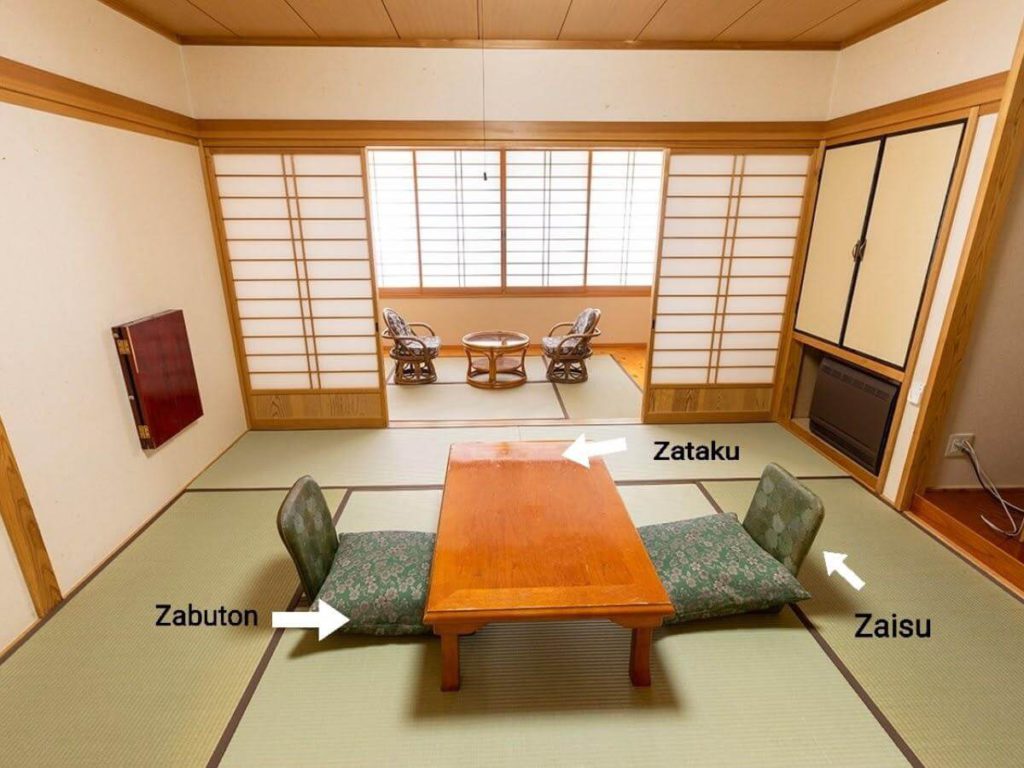
Connection to Traditional Arts
The Japanese-style tatami room spread along with the tea ceremony (茶道, sado), and at the same time, the posture of seiza became an integral part of Japanese culture. Other traditional Japanese arts, such as flower arrangement (華道, kado) and Japanese calligraphy (書道, shodo) are traditionally performed in seiza on tatami mats. Judo (柔道) is also practiced on tatami mats, and seiza is used as a form of discipline and concentration.
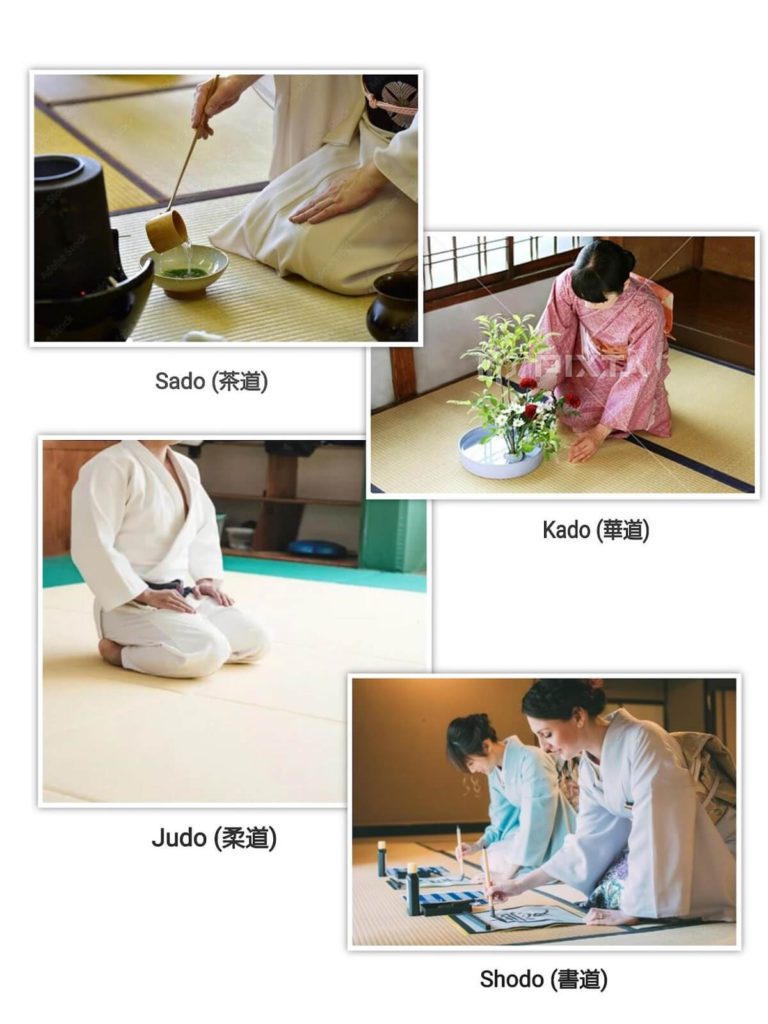
Sitting Posture on the Floor
The sight of a person wearing a kimono and sitting in seiza (正座) exudes the beauty of Japanese culture. Seiza is a traditional Japanese way of sitting, where one kneels on the tatami mat, rests on the lower legs and keeps the back straight. The posture expresses courtesy, respect for one’s surroundings, and appreciation for a culture that values grace.
Due to the rapid Westernization of Japan, people have fewer opportunities to sit in seiza in their daily lives. However, seiza has become an established manner of formal occasions and greetings. For modern people accustomed to sitting on chairs, seiza may be a sort of torture as their legs soon fall asleep. How did people in the past manage to sit for hours on end? One reason may be that they had the custom of eating in seiza as a form of discipline from an early age.
With the recent rise in popularity of yoga and meditation in Japan, many people now sit comfortably in a cross-legged position called agura, although it was taboo for women to sit in that posture in the past.
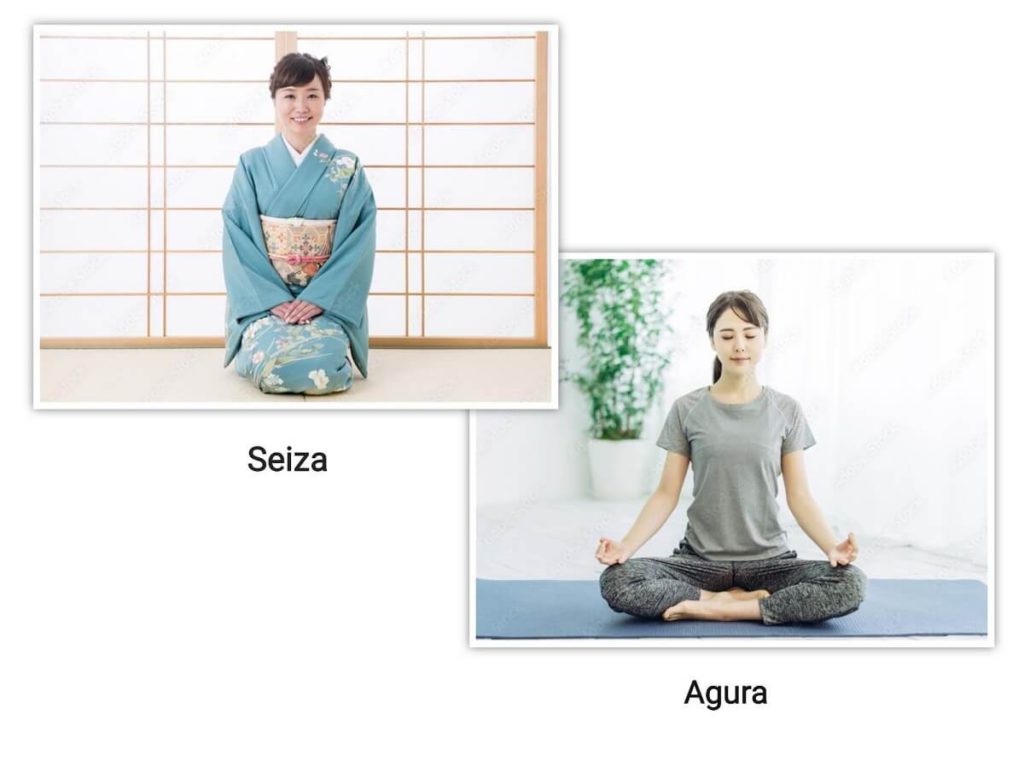
Health Benefits
While sitting on the floor may be challenging for some individuals, it offers various health benefits. It can promote good posture and flexibility, encouraging people to maintain a straight back and engage their core muscles. Additionally, sitting on the floor and getting up can help promote smooth body movement and regulate blood circulation. Furthermore, connecting with the ground can help individuals calm their nerves and enhance their mental well-being. You can use support cushions to improve comfort while sitting on the floor.
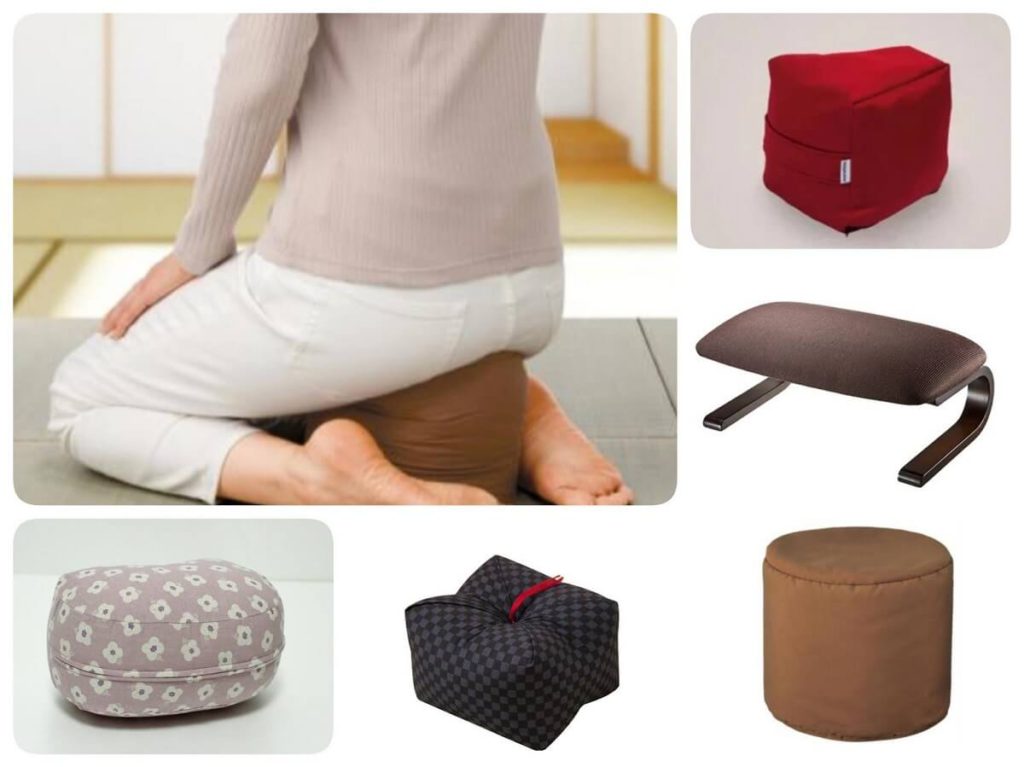
A Recent Trend of Tatami
Although the number of homes without even a single tatami room increased during the Heisei period (1989~2019), tatami rooms are now gaining popularity among people overseas in the Reiwa period (2019-). For those who are interested in Japanese culture, the Japanese-style room is one of the elements that evoke a sense of Japaneseness. The comfort of taking off their shoes and lying on tatami provides an unforgettable experience. People are attracted by the charm of tatami, including the aroma of igusa and the gentle texture it offers when they place their feet on it.
Tatami is also regaining popularity among Japanese people. Interestingly, the way of placing tatami in a part of a room, which was the ancient style of tatami culture, has caught the attention of those who have the desire to relax on the floor. Modern tatami mats are available in various materials, colors, shapes, and sizes, creating a new style that suits modern living.
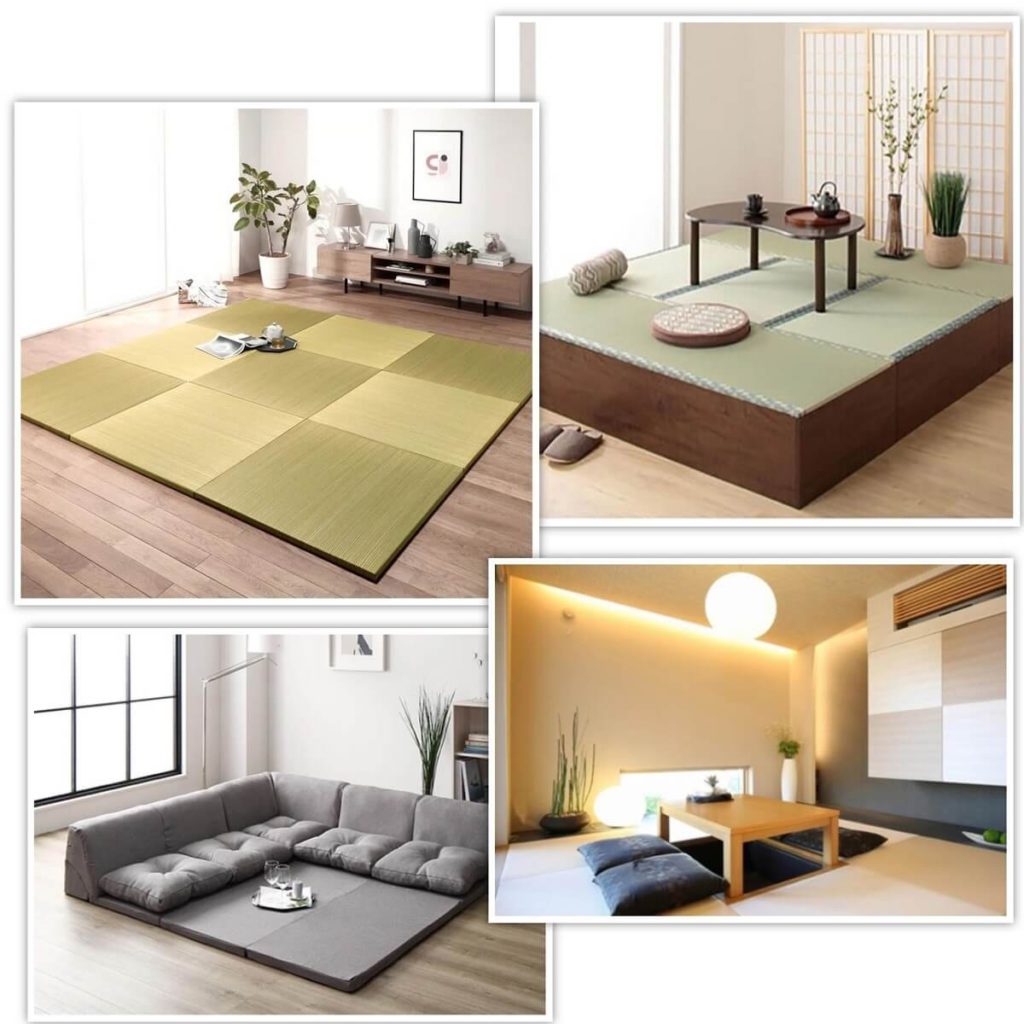
Conclusion
Let me introduce another piece of furniture that symbolizes the Japanese culture of sitting on the floor. It is a kotatsu, which is a low table covered with a blanket with an electric heater attached to the underside. During the cold winter, when you come home and place your frozen feet under the kotatsu to warm them up, you feel a sense of joy as if your heart is melting. Eating mandarin oranges while sitting under the kotatsu is a common winter tradition in Japan.

Besides being comfortable, using a kotatsu is environmentally friendly with low running costs. The design of kotatsu has also been innovated and refined in a variety of ways in modern times.
It may be a pain in the neck for some people to take off their shoes every time they enter a Japanese house. However, this custom reflects the Japanese commitment to cleanliness and hygiene and allows for a comfortable stay on the floor. If you have a chance, why not try lying down on the floor and kicking back?

Lives in Takatsuki city, Osaka. Has been engaged in English for work and fun for years.





 HTJ has a YouTube page! Check it out
HTJ has a YouTube page! Check it out
Hi, Mami san! I enjoyed your new article. I like your audio with beautiful music, too. Tatami rooms are very useful for many purposes. I didn’t know the tatami-beri patterns differed according to status! Now I understand why people have been told it is impolite to walk on a tatami-beri. Thank you for sharing about tatami and tatami related things!
Thank you for reading my article, Akiko-san. Tatami is a unique material specific to Japan. People in Japan have loved it since the old days. That’s why we can feel relaxed sitting and lying on tatami. Thank you for mentioning the audio.
Hi Mami san!
I didn’t know tatami mats have such an amazing ability! No wonder we feel comfortable on them.
I always use supporting cushions during the tea ceremony classes, they are so much helpful!
Thank you for sharing this interesting article. 🙂
Yumi
Hi Yumi-san!
I’m really glad to receive your comment. I know you are practicing the tea ceremony and interacting with foreign people. These are excellent activities. I believe that your attitude of appreciating Japanese tradition and learning English will make your life fulfilled.
Mami Yamamoto